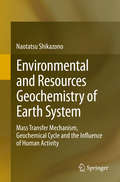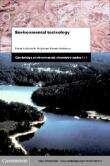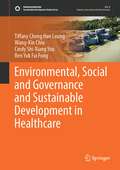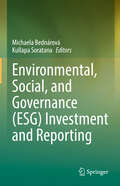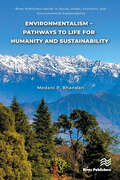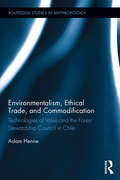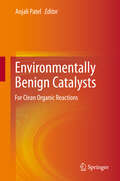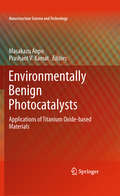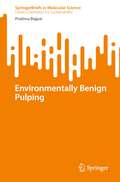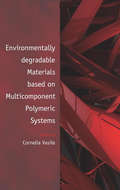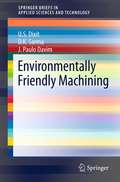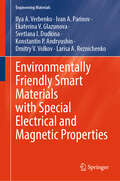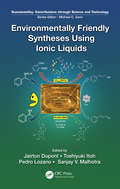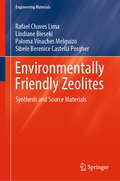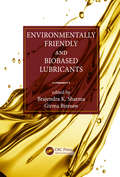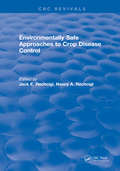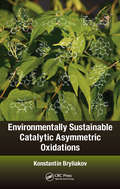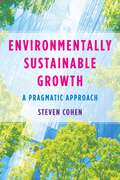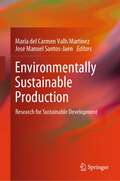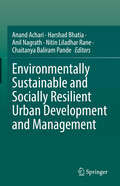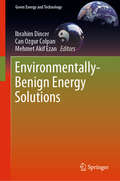- Table View
- List View
Environmental and Resources Geochemistry of Earth System
by Naotatsu ShikazonoThe Earth system consists of subsystems that include the atmosphere, hydrosphere (water), geosphere (rocks, minerals), biosphere, and humans. In order to understand these subsystems and their interactions, it is essential to clarify the mass transfer mechanism, geochemical cycle, and influence of human activity on the natural environment. This book presents fundamental theories (thermodynamics, kinetics, mass balance model, coupling models such as the kinetics-fluid flow model, the box model, and others) concerning mechanisms in weathering, formation of hydrothermal ore deposits, hydrothermal alteration, formation of groundwater quality, and the seawater system. The interaction between fluids (atmosphere, water) and solid phases (rocks, minerals) occurs both in low-temperature and also in high-temperature systems. This book considers the complex low-temperature cycle with the high-temperature cycle, a combination that has not been dealt with in previous books concerning Earth systems. Humanity is a small part of the biosphere; however, human activities greatly influence Earth's surface environments (atmosphere, hydrosphere, biosphere, soils, rocks). Thus, the influences of humans on other subsystems, particularly mass transfer in the deep underground geologic environment composed of host rocks and groundwater, are discussed in relation to high-level nuclear waste geologic disposal and CO2 underground sequestration--topics that have not been included in other books on environmental science.
Environmental toxicology
by David A. Wright Pamela WelbournEnvironmental Toxicology is a comprehensive introductory textbook dealing with most aspects of the subject, from the molecular to the ecosystem level. Early chapters deal with basic and advanced concepts, methods and approaches. The next tier discusses the environmental toxicology of individual or groups of substances. The third part addresses complex issues, in which many of the concepts, approaches and substances covered in earlier tiers are incorporated. The fourth part includes chapters on risk assessment, rehabilitation and regulatory toxicology. The book concludes with a summary of present and future areas of emphasis. Each chapter contains a comprehensive list of references and further reading, case studies from different jurisdictions, and student exercises. Environmental Toxicology is primarily a textbook for undergraduate and graduate students in environmental toxicology, environmental chemistry, ecotoxicology, applied ecology, environmental management, and risk assessment. It will also be valuable for specialists in ecology, environmental science, and chemistry.
Environmental, Social and Governance and Sustainable Development in Healthcare (Sustainable Development Goals Series)
by Ben Yuk Fong Tiffany Cheng Leung Wang-Kin Chiu Cindy Shi-Xiang YouThis book applies environmental, social and governance (ESG) to issues of sustainable development in healthcare. ESG reporting has been widely used for some time in the business industry to show the economic, social and environmental responsibilities of companies that aim to achieve superior ESG performance for lower risk, more accountability and transparency. Moreover, public-listed companies in healthcare have been growing in significant numbers in recent years. The application or practice of ESG in healthcare has become a growing trend for these large organisations looking to demonstrate their strengths in areas of financing, operations, sustainability and social responsibilities. Such an approach is essential not only for the long-term development of the companies but also for services delivered by healthcare practitioners. Equally, the implications to Sustainable Development Goal (SDG) 3 is relevant to healthcare worldwide with a growing ageing population, which has led to a great burden of care in many countries, particularly in the public sector. The potential development and expansion in private healthcare services, accelerated by technology advancement, has demanded a new paradigm in the healthcare industry, particularly in business, service delivery and policy. The book examines this paradigm through health in all policies, ESG and SDG 3 objectives, research, training and practice. It is relevant to graduate students and scholars working in areas relating to health, business and the SDGs and is also useful to policymakers and practitioners in healthcare.
Environmental, Social, and Governance (ESG) Investment and Reporting
by Kullapa Soratana Michaela BednárováThis volume provides comprehensive coverage of ESG (Environmental, Social, and Governance) principles, offering an exhaustive examination of foundational concepts, specific factors, and their integration into investment analysis, ensuring a holistic understanding of the subject. It places a strong emphasis on the ethics of investing, exploring the importance of aligning investments with personal and societal values, which enriches the reader's ethical perspective. Practical insights are provided through real-world examples and case studies, making the content more relatable and actionable. The textbook also introduces cutting-edge concepts such as Corporate Digital Responsibility and ESGD reporting, preparing readers for future developments in ESG practices and keeping them ahead of industry trends. Detailed examinations of various global ESG reporting frameworks and standards, like GRI, IR, SASB, IISB, and ESRS, equip readers with the knowledge to choose the most appropriate methods for their needs. Emphasizing the seamless integration of ESG factors into traditional investment analysis, the book enhances readers' analytical skills and demonstrates how ESG considerations can be incorporated into all aspects of investment decision-making. Additionally, by addressing contemporary issues like greenwashing and bluewashing, it makes readers aware of the ethical challenges in ESG reporting and communication, equipping them to navigate these complexities effectively. Key takeaways include an in-depth understanding of ESG principles and their impact on investment decisions, insights into ethically integrating ESG considerations into investment strategies, and practical application skills through case studies. The forward-looking content ensures readers are prepared for future trends in ESG reporting and investing, including the impact of new technologies. Familiarity with various global standards allows readers to select suitable methodologies for their contexts. The focus on holistic integration of ESG factors improves analytical capabilities, making readers adept at identifying ESG risks and opportunities. This ESG investment and reporting book is intended for a diverse audience spanning academia, professionals, and classrooms alike. Academically, it serves as a comprehensive resource for students studying finance, business management, sustainability, or related fields, offering in-depth insights into the integration of Environmental, Social, and Governance (ESG) factors into investment strategies and reporting practices. Professionals in finance, investment management, corporate governance, sustainability consulting, and ESG reporting will find it invaluable for enhancing their understanding and practical application of ESG principles in their respective industries. Additionally, educators can leverage this book as a teaching tool in university courses focusing on sustainable finance, corporate governance, or ESG investing, providing students with practical knowledge and real-world examples to enrich their learning experience.
Environmentalism – Pathways to Life for Humanity and Sustainability (River Publishers Series in Social, Urban, Economic and Environmental Sustainability)
by Medani P. BhandariThis is a comprehensive exploration of the diverse challenges and solutions related to environmentalism and sustainability. It bridges the gaps between theory and practice, offering practical insights for academics, policymakers, and change agents. It also inspires informed action and collaborative efforts for creating a sustainable future, offering new knowledge to those who care deeply about the planet and humanity’s future.The book begins with the evolution of environmentalism; tracing how ecological awareness has shaped global movements and policies. It also delves into theories of sustainability, demonstrating their relevance in addressing contemporary environmental crises. Central to the discussion is the concept of resource inequality, revealing how disproportionate resource access hinders global development and sustainability. It also explores the sustainable development goals (SDGs), presenting them as vital frameworks for policy and action, alongside climate change mitigation strategies like renewable energy, carbon sequestration, and biodiversity conservation. In the context of social equity and environmental justice, it addresses global disparities, underscoring the need for inclusive and fair solutions.Technological innovation is presented as a key driver for transforming economies into more sustainable models, including the circular economy and green finance. Furthermore, the book highlights behavioral change, mental health, and well-being as integral to advancing environmentalism.Corporate responsibility and global cooperation are examined for their roles in driving collective action, and the book emphasizes the importance of these stakeholders in addressing the environmental crisis. It also introduces the epistemology of the development economy, providing a fresh lens on sustainability that can inform both academic inquiry and practical applications.
Environmentalism, Ethical Trade, and Commodification: Technologies of Value and the Forest Stewardship Council in Chile (Routledge Studies in Anthropology)
by Adam HenneThis book explores the global connections between Chilean landscapes and Northern consumers embodied by the Forest Stewardship Council logo, the green seal of approval for certified sustainably-produced "good wood." How do we decide what makes good forestry? What knowledges and values are expressed or silenced when "good" is defined with a market mechanism like certification? Henne's ethnographic study documents the new forms of labor and the new expectations about sustainability and responsibility that certification generates, in the context of the competing ideas about how to manage a forest – or even what a forest is – that constitute forest certification in Chile. A critical analysis of certification’s practices helps understand the role of ethical trade initiatives in creating sustainable, survivable global futures.
Environmentally Benign Catalysts: For Clean Organic Reactions
by Anjali PatelOver the past twenty years, Catalysis by Heteropolyacids (HPAs) has received wide attention and led to new and promising developments both at academic and industrial level. In particular, heterogeneous catalysis is particularly attractive because it generally satisfies most of green chemistry's requirements. By emphasizing the development of third generation catalysts, this volume presents trends and opportunities in academic and industrial research. The book appeals to postgraduates, researchers, and chemists working in the field of environmentally benign catalysts as well as catalytic processes.
Environmentally Benign Photocatalysts
by Masakazu Anpo Prashant V. KamatTitanium oxide-based catalysts are especially promising as one of the most stable, non toxic, easily available photofunctional materials known today. Previously, the successful development of second-generation titanium oxide photocatalysts using an advanced metal ion-implantation technique led to reactions that could be induced not only with UV but also visible light. Since then, not only has efficiency been improved but new materials and synthesis methods have also been developed. This book will cover the various approaches in the design of efficient titanium oxide-based photocatalysts by such methods as sol-gel, precipitation, dip-coating, metal implantation and sputtering deposition. It will cover the most recent advances in TiO2 research and their potential applications as well as detailed and fundamental characterization studies on the active sites and mechanisms behind the reactions at the molecular level. The book should serve not only as a text for research into photochemistry and photocatalysis but also to inspire more applications into environmentally-harmonious technologies.
Environmentally Benign Pulping (SpringerBriefs in Molecular Science)
by Pratima BajpaiThis book provides the most up-to-date and comprehensive information on the state-of-the-art techniques and aspects involved in environment-friendly pulping technologies. Traditional chemical and semi-chemical pulping processes are not environmentally friendly. Therefore, it has become important to look for alternative approaches to mitigate wastewater emissions in the paper industry, by making more stringent regulations to improve environmental conservation. In response to this problem, new raw materials need to be explored to replace traditional choices and also new pulping processes need to be developed based on less polluting, more easily recovered reagents. This book presents new and emerging deep eutectic solvents for lignocellulosic biomass pretreatment, and discusses the effects of deep eutectic solvents on biomass pretreatment and the production of value-added products. It also introduces biotechnological methods of pulping. Biotechnological processes help to make manufacturing processes cleaner and more efficient by reducing toxic chemical pollution and greenhouse gas emissions. Given its scope, this book is of interest to applied chemists, foresters, chemical engineers, wood scientists, along with engineers and researchers involved in the pulp and paper industry as a valuable reference.
Environmentally Degradable Materials based on Multicomponent Polymeric Systems
by Cornelia VasileEnvironmentally Degradable Materials (EDPs) should replace petroleum-based plastics where recycling is not viable for logistic or labor cost reason. This book discusses the general background of obtaining such systems, compatibilization methodologies, control of the rate of degradation and final products after degradation, life time assessment, tox
Environmentally Friendly Machining
by J. Paulo Davim U. S. Dixit D. K. SarmaEnvironment-Friendly Machining provides an in-depth overview of environmentally-friendly machining processes, covering numerous different types of machining in order to identify which practice is the most environmentally sustainable. The book discusses three systems at length: machining with minimal cutting fluid, air-cooled machining and dry machining. Also covered is a way to conserve energy during machining processes, along with useful data and detailed descriptions for developing and utilizing the most efficient modern machining tools. Researchers and engineers looking for sustainable machining solutions will find Environment-Friendly Machining to be a useful volume.
Environmentally Friendly Smart Materials with Special Electrical and Magnetic Properties (Engineering Materials)
by Ivan A. Parinov Ilya A. Verbenko Ekaterina V. Glazunova Svetlana I. Dudkina Konstantin P. Andryushin Dmitry V. Volkov Larisa A. ReznichenkoThis book presents a comprehensive exploration of the research and development of modern lead-free ferroelectric piezoceramic materials (FPCMs). Authored by Russian scientists from the Rostov Scientific School on Ferro-piezoelectricity, the book looks at the theoretical and experimental challenges associated with these environmentally friendly materials. It highlights the transition from traditional lead-containing materials to innovative lead-free alternatives, emphasizing their significance in various advanced fields such as biomedicine, information technology, robotics, and precision engineering. The book provides a detailed analysis of the methodologies employed for the preparation of FPCMs, the impact of structural inhomogeneities on their properties, and the development of new active materials. It also covers the extensive experimental data on the modification of solid solutions, the influence of different modifiers, and the resulting electrical, dielectric, and mechanical characteristics. This book serves as an essential resource for researchers, engineers, and students interested in the cutting-edge advancements in environmentally friendly smart materials and their wide-ranging applications.
Environmentally Friendly Syntheses Using Ionic Liquids (Sustainability: Contributions through Science and Technology)
by Jairton Dupont Pedro Lozano Toshiyuki Itoh Sanjay V. MalhotraIncreased environmental consciousness within the scientific community has spurred the search for environmentally friendly processes as alternatives to conventional organic solvents. In the past two decades, numerous advances-including the use of ionic liquids-have made it possible to develop substitutes for some toxic solvents. Ionic liquids are wi
Environmentally Friendly Zeolites: Synthesis and Source Materials (Engineering Materials)
by Lindiane Bieseki Rafael Chaves Lima Paloma Vinaches Melguizo Sibele Berenice Castellã PergherThis book details zeolites, their structures and the parameters that influence their synthesis, providing a new and actual perspective of this field. Following this, the authors show different processes used to synthesize zeolites using residues, natural materials, and other eco-friendly materials such as raw powder glass, clays, aluminum cans, diatomites, rice ashes or coal ashes. Finally, this book gives the reader a wide range of different synthesis methods that they can be applied to several industrial processes.
Environmentally Friendly and Biobased Lubricants
by Brajendra K. Sharma and Girma BiresawA Comprehensive Review of Developing Environmentally Friendly Lubricants A push from environmentally savvy consumers along with recent changes in governmental regulations have paved the way for a marketplace of products with high levels of environmental performance. Fueled by the growing demand for biobased lubricants, Environmentally Friendly and Biobased Lubricants highlights the development of environmentally friendly additives that are compatible with environmental regulations and describes the approaches being used in this emerging area. Derived from research topics shared over the years at various technical sessions of the Society of Tribologists and Lubrication Engineers (STLE) Annual Meetings, the book includes a critical assessment of gaps and weaknesses in the field of environmentally friendly fluids and biobased lubricants. Each chapter is written by authors selected from the environmentally friendly fluids and biobased lubricants sessions of STLE and also incorporates input from prominent researchers invited to take part in the book. Expert contributors discuss the control, production, usage, and disposal of lubricants; factor in related policies, laws, and regulations around the world; and include case studies demonstrating the uses and values of commercially viable biobased lubricants. The book is divided into five sections that cover advanced environmentally friendly base oils and feedstocks, biobased hydraulic lubricants and biodegradability, chemically/enzymatically modified environmentally friendly base oils, vegetable oil–based environmentally friendly fluids, and additives for environmentally friendly fluids.
Environmentally Safe Approaches to Crop Disease Control (Agriculture And Environment Ser.)
by Jack E. RechciglThe use of chemicals in agriculture and home gardens has become an area of concern due to improper use and negative environmental effects. Environmentally Safe Approaches to Crop Disease Control addresses alternative approaches for managing crop diseases. It gives a balanced overview of state-of-the-art environmentally safe approaches to crop disease control and discusses the latest trends.
Environmentally Sustainable Catalytic Asymmetric Oxidations
by Konstantin BryliakovCatalysis plays a vital role in chemical, petroleum, agriculture, polymer, electronics, pharmaceutical, and other industries. Over 90 percent of chemicals originate from catalytic processes. Toughening economic and environmental constraints have proven to be a challenge for meeting the demand of novel efficient and sustainable regio- and stereosele
Environmentally Sustainable Growth: A Pragmatic Approach
by Steven CohenHow do we move away from the current environmentally destructive economic system toward one that is more sustainable while still ensuring continued economic growth? This book offers a positive vision of an environmentally sustainable future and lays out the steps ahead as we make the transition.Steven Cohen explores the causes of environmental degradation and examines what sustainability looks like in practice. He outlines realistic paths toward a renewable resource–based economy, demonstrating that, in many respects, the shift to sustainability is already underway. Cohen describes a range of public policy and infrastructure initiatives that can encourage cleaner production in the private sector and consumption in everyday life. He argues that the politics, advocacy, and communication around environmental protection must change to emphasize successes, reduce scare tactics, and make sure that the lifestyles and careers associated with a more sustainable world sound attractive to a wide range of people. The book depicts an appealing and equitable future that assures quality of life while protecting the planet.Environmentally Sustainable Growth brings together insights from many disciplines, spanning the latest scholarship and practical experience. Useful for students and courses, this book will be informative for practitioners, managers, analysts, activists, and scholars whose work incorporates environmental sustainability.
Environmentally Sustainable Production: Research for Sustainable Development
by María del Carmen Valls Martínez José Manuel Santos-JaénIn this book, world-leading researchers in corporate sustainability explore the importance of considering environmental, social, and governance criteria to ensure the survival and profitability of a company, as well as the protection of people and the planet. The book serves as a resource for company executives and managers seeking to implement sustainable practices, investors and shareholders interested in how companies address environmental and social challenges, students and academics studying issues related to sustainability and corporate social responsibility, consulting and advisory professionals, and sustainability activists and advocates seeking to learn more about how companies can be part of the solution to environmental and social problems. The authors provide a collection of chapters that rigorously address the contribution of business to sustainable development, making it a valuable resource for anyone looking to understand the importance of sustainability in business.
Environmentally Sustainable and Socially Resilient Urban Development and Management
by Chaitanya Baliram Pande Nitin Liladhar Rane Anand Achari Harshad Bhatia Anil NagrathThis book is an extensive guide that covers topics related to building sustainable and resilient urban environments. The book delves into crucial issues such as energy efficiency, air quality, climate change mitigation and adaptation, solid waste management, transportation, water balance, and flood control. This book is mainly intended for urban planners, policymakers, environmental managers, and researchers who are involved in urban development and management. It provides a thorough analysis of the current state of urban development and its impact on the environment and society. Furthermore, the book offers practical solutions and tools for improving sustainability and resilience. The topics addressed in this book are of utmost importance due to the increasing concerns about the impact of urbanization on the environment and society. The book highlights the challenges of rapid urbanization, such as air pollution, energy consumption, waste management, and water scarcity. It offers insights into sustainable and resilient urban development and management practices to tackle these challenges. The primary aim of this book is to provide a comprehensive overview of the latest tools and techniques for sustainable and resilient urban development and management. It provides practical solutions and case studies to demonstrate how these tools can be utilized to improve sustainability and resilience in urban environments. Additionally, the book seeks to increase awareness among urban planners, policymakers, and managers about the significance of sustainable and resilient urban development and the potential benefits of implementing these practices.
Environmentally-Benign Energy Solutions (Green Energy and Technology)
by Ibrahim Dincer Can Ozgur Colpan Mehmet Akif EzanThis book provides high-quality research results and proposes future priorities for more sustainable development and energy security. It covers a broad range of topics on atmospheric changes, climate change impacts, climate change modeling and simulations, energy and environment policies, energy resources and conversion technologies, renewables, emission reduction and abatement, waste management, ecosystems and biodiversity, and sustainable development. Gathering selected papers from the 7th Global Conference on Global Warming (GCGW2018), held in Izmir, Turkey on June 24–28, 2018, it: Offers comprehensive coverage of the development of systems taking into account climate change, renewables, waste management, chemical aspects, energy and environmental issues, along with recent developments and cutting-edge information Highlights recent advances in the area of energy and environment, and the debate on and shaping of future directions and priorities for a better environment, sustainable development and energy security Provides a number of practical applications and case studies Is written in an easy-to-follow style, moving from the basics to advanced systems. Given its scope, the book offers a valuable resource for readers in academia and industry alike, and can be used at the graduate level or as a reference text for professors, researchers and engineers.
Environments
by Lawrence Hall of Science University of California at BerkeleyNIMAC-sourced textbook
Environments
by Lawrence Hall of Science University of California at BerkeleyNIMAC-sourced textbook
Environments and Survival: Snails, Robots, and Biomimicry
by The Lawrence Hall of ScienceNIMAC-sourced textbook
